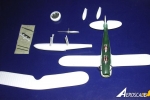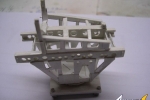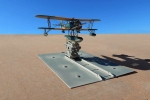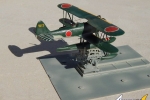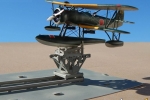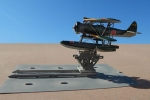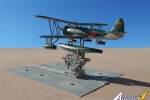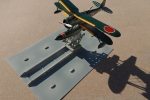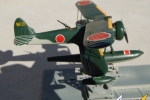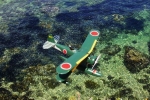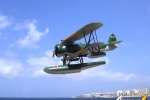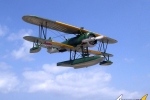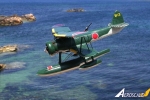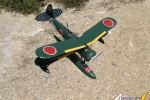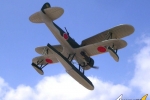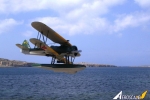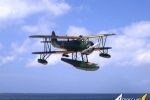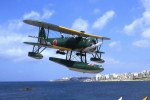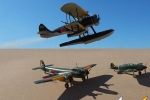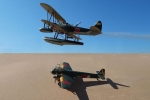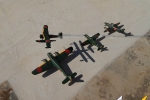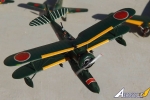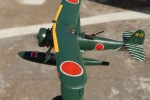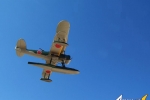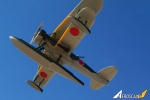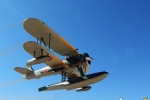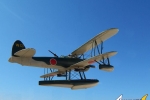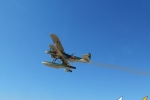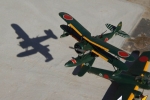1⁄72Nakajima E8N1
3
Comments
History
Before the start of the last war the Imperial Japanese Navy issued an 8-shi specification for a 2-seat, catapult launch, short-range reconnaissance floatplane to replace the Type 90 Nakajima E4N2…a design derived from the original Chance Vought 02U-1 “Corsair” of the 1920s. Nakajima won the contract, which was designated as the Type 95 reconnaissance Float Plane Model 11, the E8N1 and which had the allied code name ‘Dave’. This proved to be a highly successful design with a service life matched only by the Kawanishi E7K1-2 “Alf”.The E8N1 was exceptionally maneuverable for a floatplane having rugged construction and was powered by a 580 hp Kotobuki 2 Kai 1 nine-cylinder radial air-cooled engine. A later version, the E8N2 was powered by the 630hp Kotobuki 2 Kai II engine with the only outward appearance change being the location of aileron connecting rod being placed further to the edge of the trailing edge. Armament consisted of one fixed forward firing 7.7 mm machine gun and one flexible 7.7 mm gun at the rear seat plus two 66lb or 132 lb bombs slung under the wing racks.
‘Dave’ saw service in China as a fighter, dive bomber and observer but its primary role was a short-range reconnaissance for aircraft tenders, battleships and cruisers of the Imperial Japanese Navy ranging from the Aleutians to the Philippines and throughout the vast reaches of the Pacific wherever the IJN roamed.
Production was terminated in early 1940 after 755 ‘Daves’ had been produced, 48 having been built by Kawanishi who were one of the original competitors for the contest. One of its last roles was as a spotter during the Battle of Midway in 1942. The type was thereafter replaced by the Aichi E13A1 ‘Jake’ and the Mitsubishi F1M ‘Pete’. ‘Dave’ continued in service as a trainer, liaison and coastal patrol before being expended as a “Kamikaze” attacker. There are no known surviving examples. The E8N1 had a wingspan of 36’; length of 29’ 10-3/4”, a height of 12’7”. Empty weight was 2,900 lbs; loaded 4,189 lbs. Maximum speed was 186 mph at 9,845 ft and service ceiling 23,850 ft and had a range of 558 st.miles.
The Kit
The kit comes in a polytene bag containing two sheets of white styrene with all the kit vac-form parts, nicely presented on them. One sheet contained four wing halves, upper and lower; central float parts, two side wing floats, two crew seats, and printed struts and other smaller items. The other sheet, which is half the size of the first sheet, contained two radial engine rows, the two tail plane parts, a propeller and two fuselage halves. A good quality decal sheet with just six Japanese meatballs is also included.The instruction sheet is quite comprehensive containing color details in 2-tone side views of the basically dark green upper and light gray lower while other shore based types carried dark earth and dark green upper camouflage in contrast to early machines in overall silver and red tail unit. There is also a brief history of the aircraft; a scrap side view depicts the differences between the E8N 1 and E8N 2 derivatives. The last page is dedicated to the assembly instructions, an exploded view of the kit parts, reference material and a detailed sketch of the 7.7 mm Type 89 machine gun complete with flat drum magazine containing 68 rounds. This is a quick easy reference when building the rear m/c gun even at such a small scale.
Construction
The Dave is a very small biplane kit by comparison to usual wartime biplanes. Having built several vac-form kits my observation is that they go more or less by the same method and I will be describing in brief detail the method as directed by the ‘Wings’ kit instructions.The kit parts were first lightly scribed around individually but avoiding cut through as we do so using a sharp X-acto blade. These parts are then snapped from the backing sheet. The mating edges are then sanded perfectly flat on a 400 grid wet and dry sanding paper fixed to a flat piece of plate glass or other smooth surface. Wing joints and seams are treated with ‘Plasto’ filler, and then sanded smooth, and ready to be fitted. At this stage this applies to the floats, wings and cowling.
To the fuselage which has beautiful surface ripples running all along, a floor is cut from the backing sheet, trial fit and fixed in place, adding seats, instrument panels, column, gun assembly, rudder bars and other side instruments that may be present. Interior grey green paint is applied to the wall sides and floor and the fuselage halves can be mounted together. Lower wings are mated and allowed to set. Two windshields are shaped and cut from clear acetate sheet and applied to the front of each cockpit aperture. Seat straps cut from masking tape strips are added to the leather brown seats. Other detail in grey and black paint is applied.
The central float has two metal strips cut to equal lengths and these are applied to the sides forming two streaks running the length of the float sides. This small detail makes a difference to a small graceful float plane. Boarding-step is added to the port side. This is made from a thin steel wire cut in form of ‘U’ shape and fitted in two small-predrilled holes. A tiny motor is fitted to the upper wing leading edge complete with a tiny 2-blade propeller. Wind speed indicator is added to starboard wing strut. Other details like gun sight, bomb shackles. Tie brackets are fixed to front of float and rear of fuselage made from bent wire bent and cut to size. Cutting the printed wing struts was too much of a hassle and instead I made these struts from narrow metal tubes cut to size. A small pin is inserted at each end. The rest of the strut is then flattened in the jaws of a vice.
Before going to the next important stage of fitting the upper wing on the wing struts the upper fuselage is painted in green camouflage. This is done at this stage, as the area will be difficult for the paint to reach all localities if the upper wings are in place. Windshields are also hand painted and later masked using Maskol. Since the struts have locating pins their location is first marked and then drilled. Other holes to take the wire bracing are also drilled at this stage. The struts (fuselage and outer ones) are fixed in place using super glue and checking them with an angle gig made from cardboard shown. This will ensure the correct angle of inclinitation of the strut to the horizontal surface of the lower wing. A suitable metal propeller was added from one available at a cottage industry. After paintwork two small bombs were added under the wing racks.
Rigging Painting and decalling
I have used invisible thread for the tail and wing struts but for the floats struts, which were of a thicker nature, I used steel wire.The model was carefully masked and airbrushed in Humbrol dark green N1and light grey N10. Orange yellow N15 leading edge recognition panels on both wings, Prop was silver with two red stripes. White rear gunner deflection stripes painted on the horizontal tail surfaces that radiate in 5 degrees increments. A red propeller-warning stripe was hand painted on top center only on main float. White trestle marks are on sides of main float (these were still to be applied when pictures of the kit were taken).
Since my kit represented an N2 version the aileron connecting rod is fixed to rear position. The E8N2 represent the Dave of IJN HC ‘Nachi’ in 1943 during the cruiser’s operations in the Aleutian Islands as the first ship of the 21st Sentai. Red Hinomaru with white surrounds on upper wing while those of lower were without the white surrounds. Most were found from decal spares box, as the ones given were oversize. Kit was given another coat of Klear and finally airbrushed in semi gloss lacquer.
Trolley and cradle assembly
A trolley and a carrier were built, the type used on Imperial Japanese warships to mount and launch the E8N2. The main trolley was built from 0.5mm plastic card cutting the required shapes with a sharp X-acto pointed blade, and using a set of fine drills and needle files. The trolley consisted of a front, back and bottom panels, a turntable and a framed base plate. Five bracing struts were glued internally to give the required strength to the erected trolley assembly. A float cradle was then constructed using 20 thou thick plastic card, adding small details to the surface. The entire assembly was sanded smooth and given an overall coat of steel gray. The trolley assembly was attached to the base made from an A5 size sheet of plastic card that had a pair of rails mounted on it made from strips from contrail struts. A little dry brush in silver gave the working parts the worn appearance. The E8N2 was then lowered and displayed on the float cradleConclusion
All in all was found to be a very accurate kit dimension-wise. Being a vac form kit this could involve more work for the modeler but considering how soft the white styrene is one could only be careful to avoid over sanding, the rest was quasi plain sailing. I am pleased with the end result and maybe my next build will be a Pete made by Wings as I read it is another accurate kit in the same range of WWII series of models.Comments
Carmel; you continue to amaze with your expertly assembled unique subjects! A "Dave"! And I still love your photography. Who makes this kit and who the Kyushu Q1W Tokai?
MAR 28, 2014 - 04:50 PM
Excellent work again from the Maltese plastic guru, when i did built 72nd, I loved the wings vac series as they provided unusual subjects... and a lot of fun! Best regards Carmel!
MAR 28, 2014 - 09:32 PM
The Kyushu QiWi Lorna is made by Pavla Models of Czech Rep. Really nice kit to build. Dave is made by Wings, vac series. Still have a Pete from that range waiting to be built. Ki-60 is an RS Models and the Kikka is an MPM kit.Thanks for the kind comments.
MAR 29, 2014 - 01:22 AM
Copyright ©2021 by Carmel John Attard. Images also by copyright holder unless otherwise noted. The views and opinions expressed herein are solely the views and opinions of the authors and/or contributors to this Web site and do not necessarily represent the views and/or opinions of AeroScale, KitMaker Network, or Silver Star Enterrpises. Images also by copyright holder unless otherwise noted. Opinions expressed are those of the author(s) and not necessarily those of AeroScale. All rights reserved. Originally published on: 2014-03-29 01:08:44. Unique Reads: 6440





